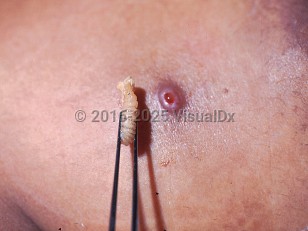Myiasis in Adult
Alerts and Notices
Important News & Links
Synopsis

Cutaneous myiasis, also known as dermal myiasis, human botfly, warble fly infestation, or tumbu fly infestation, is a self-limited fly larval infestation of the skin or skin appendages. It is a common disease of the traveler returning from South America (with a high incidence of exposure and infection in Belize and Bolivia) or sub-Saharan Africa.
Infestation occurs when ova are laid on the skin or clothing by any number of species of fly of the order Diptera. The ovum will hatch, enter human skin, and form a small papule within 24 hours of contact with skin. The lesion will enlarge as the larva grows in size. If left unattended, the larva will eventually mature and emerge on its own. Cordylobia anthropophaga (the tumbu fly, found in sub-Saharan Africa) larvae mature within 1-3 weeks, whereas Dermatobia hominis (the human botfly, found in the Americas) take upwards of 3 months. Dermatobia hominis ova are transmitted by mosquitoes (the fly lays its eggs on the mosquito and they are dropped off on the human while the mosquito is feeding). Cordylobia anthropophaga ova are deposited on wet clothes and enter the skin when the clothing is worn.
There are 3 cutaneous forms of disease: furuncular, wound, and migratory.
The furuncular form is caused by D hominis and C anthropophaga. Lesions begin as small erythematous papules, which may be single or multiple and enlarge as the larva enlarges into furuncles with a distinct central punctum. The patient may complain of pruritus or movement or pain within the lesion. With light palpation, the clinician may be able to feel the larva move.
Wound myiasis is caused by the larvae of Cochliomyia hominivorax (New World screwworm fly) and Chrysomya bezziana (Old World screwworm fly). Patients may report bleeding and pain within preexisting wounds. In this particular form, constitutional symptoms, such as fever and chills, and laboratory abnormality with leukocytosis and eosinophilia may be seen. If wound myiasis occurs on a periorificial location on the head, the larvae can burrow into the nasal bones, eyes, or brain tissue, with serious sequelae including sepsis, blindness, and death.
Finally, migratory or creeping myiasis is caused by Hypoderma bovis or Gasterophilus intestinalis larvae. Clinically, migratory myiasis presents as pruritic serpentine lesions similar to those of cutaneous larva migrans. This form is found in patients working or living near cattle and horses.
Myalgias may represent myiasis due to a less common species of botfly (Hypoderma lineatum).
Larval infestation of the eye (ophthalmomyiasis) may be internal or external.
Infestation occurs when ova are laid on the skin or clothing by any number of species of fly of the order Diptera. The ovum will hatch, enter human skin, and form a small papule within 24 hours of contact with skin. The lesion will enlarge as the larva grows in size. If left unattended, the larva will eventually mature and emerge on its own. Cordylobia anthropophaga (the tumbu fly, found in sub-Saharan Africa) larvae mature within 1-3 weeks, whereas Dermatobia hominis (the human botfly, found in the Americas) take upwards of 3 months. Dermatobia hominis ova are transmitted by mosquitoes (the fly lays its eggs on the mosquito and they are dropped off on the human while the mosquito is feeding). Cordylobia anthropophaga ova are deposited on wet clothes and enter the skin when the clothing is worn.
There are 3 cutaneous forms of disease: furuncular, wound, and migratory.
The furuncular form is caused by D hominis and C anthropophaga. Lesions begin as small erythematous papules, which may be single or multiple and enlarge as the larva enlarges into furuncles with a distinct central punctum. The patient may complain of pruritus or movement or pain within the lesion. With light palpation, the clinician may be able to feel the larva move.
Wound myiasis is caused by the larvae of Cochliomyia hominivorax (New World screwworm fly) and Chrysomya bezziana (Old World screwworm fly). Patients may report bleeding and pain within preexisting wounds. In this particular form, constitutional symptoms, such as fever and chills, and laboratory abnormality with leukocytosis and eosinophilia may be seen. If wound myiasis occurs on a periorificial location on the head, the larvae can burrow into the nasal bones, eyes, or brain tissue, with serious sequelae including sepsis, blindness, and death.
Finally, migratory or creeping myiasis is caused by Hypoderma bovis or Gasterophilus intestinalis larvae. Clinically, migratory myiasis presents as pruritic serpentine lesions similar to those of cutaneous larva migrans. This form is found in patients working or living near cattle and horses.
Myalgias may represent myiasis due to a less common species of botfly (Hypoderma lineatum).
Larval infestation of the eye (ophthalmomyiasis) may be internal or external.
Codes
ICD10CM:
B87.0 – Cutaneous myiasis
SNOMEDCT:
60412004 – Myiasis
B87.0 – Cutaneous myiasis
SNOMEDCT:
60412004 – Myiasis
Look For
Subscription Required
Diagnostic Pearls
Subscription Required
Differential Diagnosis & Pitfalls

To perform a comparison, select diagnoses from the classic differential
Subscription Required
Best Tests
Subscription Required
Management Pearls
Subscription Required
Therapy
Subscription Required
References
Subscription Required
Last Updated:06/02/2025
Myiasis in Adult

